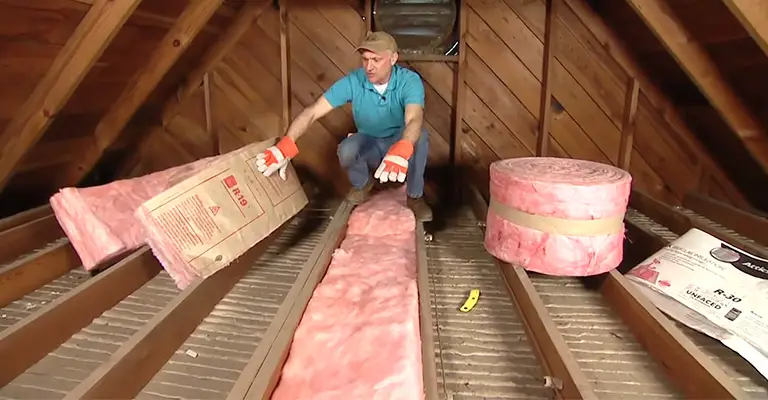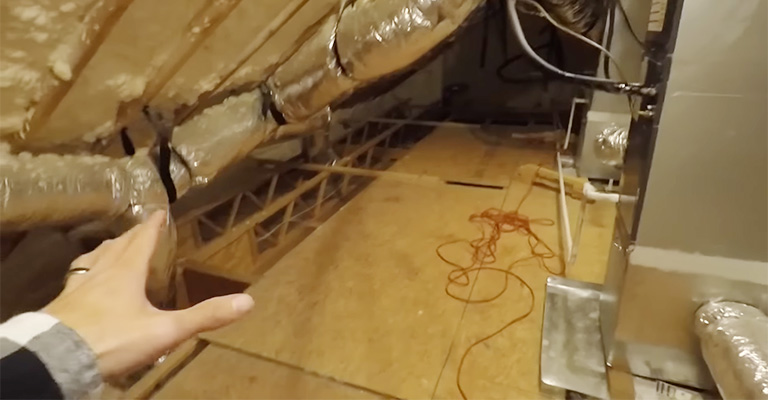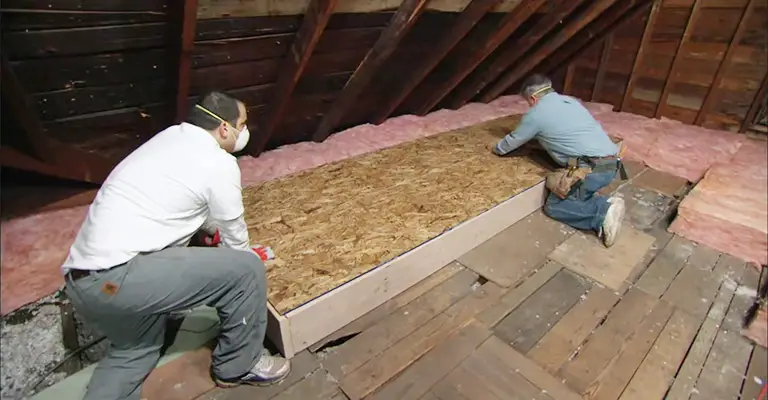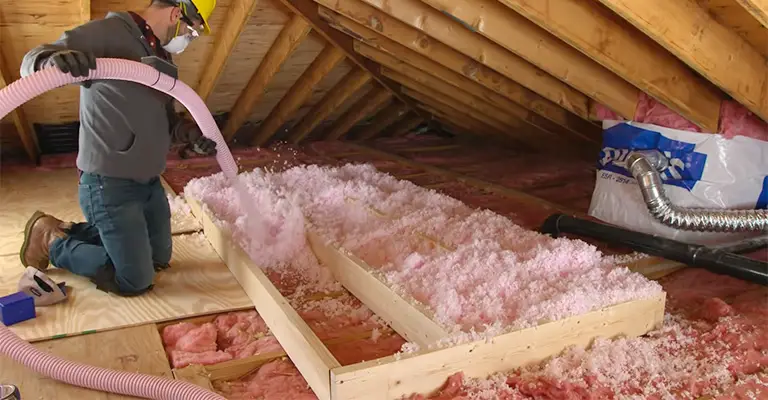Navigating through an attic can be a daunting task, especially when you’re faced with the challenge of maneuvering around blown insulation.
Blown insulation, consisting of loose fibers or particles, is commonly used to improve the energy efficiency of a building.
However, it can create an uneven surface that poses risks for those needing access to their attic for maintenance, repairs, or storage purposes. With all that insulation, how do I move around?
To walk in attic with blown insulation, you should sweep, rake, push, and move the insulation away from areas you wish to use as pathways (down to the joist tops).
The advantage of this is that you can see what you are walking on, and you won’t have to go back down to the floor below.
Then, if you’re uncomfortable walking on the joists, find or cut 1 ft x 8 ft strips of 3/4 or 3/4 ply (1/2 is fine if you’re not too big).
At this point, temporarily tack these to the joists if you’re still uncomfortable. Alternatively, if you are comfortable kneeling and working off the joists, you can use a shorter piece of plywood as a platform.
As soon as you’re done, either leave the walkway or recover it with the insulation. Alternatively, you can remove them and replace the insulation if you have moved.
Proper Way To Walk In An Attic If It Has Blown-In Insulation

A key aspect of blown insulation is that every layer must remain intact and undisturbed for it to be effective. Your protection can be disrupted if you start walking in an attic with blown insulation.
Stepping displaces vital materials, potentially resulting in the insulation not working correctly and shivering during the cold winter months.
As a result, if it is necessary for you to go up into your attic, you should make a plan in advance and follow it closely. We recommend trying the following steps:
Identify Where You Must Go

Take a moment to look around your attic before you head up there. Can you tell me what path is best for you?
Choose Strong Joists
The cross-pieces in your attic are plentiful, so choose the ones that follow your path carefully!
Grab Planks
The joists might cause you to trip if you walk on them. Furthermore, your foot might crash through the ceiling, leaving you with a messy mess to clean up. The best way to balance the boards is to place them over the joists.
Inspect Your Work
Looking down will help you recall your starting position as you walk back. Ensure that the insulation is positioned properly if it has been disturbed.
You should ensure your contractors know how to walk into an attic with blown insulation before hiring them! In that case, you should inform them that you have this type of insulation.
Similarly, your contractors may be able to let you know in advance if they aren’t familiar with it. It will prevent you from experiencing unnecessary stress and possible mess.
I Need to Clean Up the Insulation In My Attic. How Do I Walk There?

The problem is very common for those who have blown-in insulation and find they need to clean their attic, but they don’t know how to do so.
Some extra effort will be involved, but it should be pretty straightforward overall. Either of the following approaches are possible:
Lay Down Loose Walking Boards
The current solution is much more efficient than the previous one and won’t be as messy. Taking these steps is the appropriate course of action in this case:
- You must find a suitable set of wooden walking boards (planks would be best). Generally, you may want to use board sizes of 2 x 6
- You need to ensure they can handle your weight
- Directly lay the planks over the insulation. It is possible to lose some of the effectiveness of insulation if the insulation is not thick enough
- If you want, you can also lay the planks on the joists to resemble a catwalk
Sweep the Insulation From the Joists
The easiest way is to follow these steps. Your first step will be to find suitable boards that are easy to walk on. If they are on the plain, ensure they are straight and don’t wiggle too much.
When you have found such boards, go to the attic, and carefully remove the insulation from the joists. Also, try to keep it clean here, as it may get messy with the overall efficiency of the heat insulation.
When you have finished that task, gently place the insulation back in its original location. Thus, to summarize, everything will work out as follows:
- Find a stable and suitable worksurface
- Take down the rigid foam board in the attic to remove the insulation
- Upon completion, restore the insulation to its previous position
You can also remove the insulation using a shovel with a fixed handle. Nothing should be wrong with it.
In the attic with blown-in insulation, you now know what to do so that your trip there is both safe for you and the insulation. Additionally, you are more aware of the benefits and disadvantages of this type of insulation.
This will hopefully allow you to decide whether blown-in insulation would be ideal for you.
How to Stay Safe While Working In the Attic?

It doesn’t matter whether you do the repairs yourself or hire someone else to do them. It’s always important to keep safety in mind.
Most attics have many cables, wires, and pipes, making them potentially dangerous for people to stroll through.
It is important to remember that there can also be asbestos, especially in older houses, along with potentially hazardous materials, insects, or high temperatures.
Consequently, you should review a few safety tips before working in the attic. Hire someone to do the job for you to ensure your attic is safe.
Here are some safety tips and precautions to consider before going into an attic or letting someone else do so:
Bring a Light Source
You should carry a flashlight and a work light. No matter how bright your attic is, we recommend bringing a flashlight with you. Using a flashlight, you can check places where light cannot reach.
Wear Appropriate Shoes
A large number of the attics are cluttered with electrical wires, plumbing, ductwork, and cross braces. For this reason, create a platform or use walk boards if you plan to walk on them.
Wear a Respirator
Whenever you are working with chemicals, you need to wear a respirator. It will usually be enough to keep something from getting into your lungs.
It is important to always wear a respirator to protect yourself against dust, airborne fibers, and harmful materials that can be inhaled. If you want to prevent anything from getting into your eyes, you should also wear goggles or safety glasses.
Wear Suitable Clothes
It is a good idea to wear the standard costume that consists of pants and gloves with a long sleeve shirt before entering an attic.
You will be protected against irritation as well as insulated. You might also want to consider wearing a baseball cap or hoodie to prevent any nails or scrapes from showing. It is also possible to use a hard hat in this situation.
Caution: Do Not Disturb the Insulation
Ensure you never touch the insulation since it can stick to your clothes and find its way into your living space! Also, this insulation will prevent fibres, mould, dust, and dirt from building up in the attic.
You might want to vacuum yourself off after you have come down from the attic because you can’t always stay awake.
It should be left as it is even if you find a tube, knob, cloth-covered wiring, old wiring, signs of animals, or vermiculite insulation. Make sure you do some research before you get rid of these items, and then hire an expert to do so.
Final Words
The knowledge you have gained can be applied to walking in the attic with insulation and getting ready for the visit and how to avoid or avoid dangerous situations in your attic.








